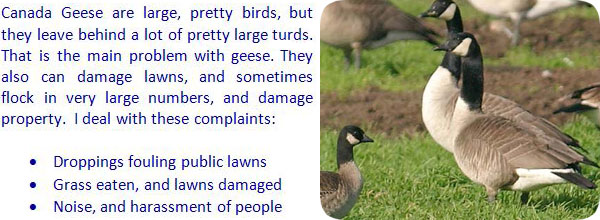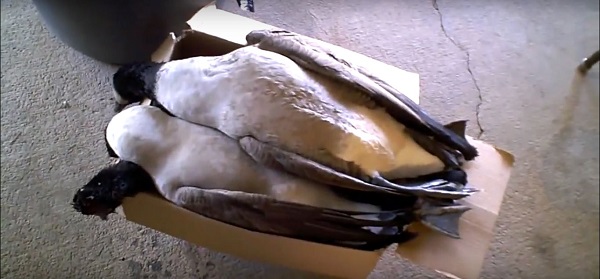 If you need help, click my Nationwide List of Canada Goose Removal Experts for a pro near you.
If you need help, click my Nationwide List of Canada Goose Removal Experts for a pro near you.
Killing Canada geese can be controversial with the rise in political concerns over “animal rights” supported in most major urban areas around the United States these days. Whether your purpose is to control the goose population with alternatives to outright killing, hunting the birds with firearms, or killing goslings or destroying eggs, you would be wise to consult with local, state and federal authorities in order to avoid running afoul of any pertinent laws.
If you’ve decided to kill the geese, then there is much you should know and master before loading your shotgun and racking up a bird body count.

Hunting is the leading cause of death among Canadian geese in North America. However, geese flocks can be challenging to target in urban areas. Hunting seasons and “bag limits” in the wild are different from urban settings. Regulations to enhance waterfowl migration cover Canadian geese because they are migratory birds. Regulatory guidelines often cover flyway territories which may incur upon urban areas outermost development perimeters.
Canadian geese flocks have settled in urban areas and no longer migrate. Those urban areas will have restrictive firearm regulations which can prohibit hunting altogether within certain incorporation limits. Popular opinion is growingly cited as being against hunting geese in urban areas by as many as one in four residents. Check with local, state and federal authorities to see if and when hunting is allowed.
Hunting the Canada geese in urban areas is the most effective way to manage the population. Reducing the adult population dramatically affects mating success and egg laying. Gunshot sounds provides an acoustic deterrent to feeding and nesting behavior and reduces the protected areas geese like in order to grow their families.
You may find that before you can bag Canadian geese that you will need to be clear about the governing firearm restrictions, waterfowl hunting season requirements, and special stamps required on your hunting license(s). A “special kill permit” (SK permit) can be issued as part of state managed “harassment programs” to keep the birds from settling in specific urban areas. The SK permit is generally issued to hunters who will be hunting on or near municipal golf courses, parks and urban wilderness areas and green spaces, regional airports, and industrial parks on the edge of town.
Shotguns are the preferred firearm for hunting Canadian geese. Non-toxic steel shot is required. A forty yard killing range is optimal to minimize chances of hitting non-target animals. Shot loads vary as to type. BB, triple B, and T-type loads are recommended. Remember that each permit has different standards for allowable loads.
If you hunt Canada geese as part of a special control program where an SK permit is required, you may need to be knowledgeable and compliant with other program components such as shoot times and locations/kill zones, shooter accuracy testing, hunter orientation meetings, shell and gun size restrictions, decoy applications, kill documentation, and local law enforcement standards, practices and cooperation programs.
Airports present special program and practice circumstances for hunters. One goose can cause an in-flight jet engine to fail with a crash resulting within minutes of impact. Nesting grounds near airports are usually targeted for intensive annual hunts. Referred to as “annual treatments”, hunters will kill nesting geese on-site to reduce the chances of damage to aircraft and passenger deaths. Treatment will include habitat destruction to prevent other Canada geese from moving into the emptied habitats.
Some states have permitted on a limited basis the use of goose meat to stock local food banks. Some communities find this an acceptable practice. It is quite controversial in others. Where goose harvesting is employed to control the nuisance population, the geese are captured and fed before processing. In only rare instances have communities implemented hunting programs where the kill product is processed and distributed to food banks directly. USDA licensed processing facilities are generally required. Special metal detection equipment is necessary in order to detect steel shot in the gooseflesh.
The major downside to processing goose meat for human consumption is the presence of pesticide residues in tissue. These residues are mainly found in Canada geese with a migratory history through croplands where pesticides are used for weed and insect control during spring and summer growing seasons. Sedentary, non-migratory Canada geese hatched in urban areas have been generally exempt from pesticide exposure.